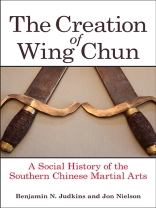This book explores the social history of southern Chinese martial arts and their contemporary importance to local identity and narratives of resistance. Hong Kong’s Bruce Lee ushered the Chinese martial arts onto an international stage in the 1970s. Lee’s teacher, Ip Man, master of Wing Chun Kung Fu, has recently emerged as a highly visible symbol of southern Chinese identity and pride. Benjamin N. Judkins and Jon Nielson examine the emergence of Wing Chun to reveal how this body of social practices developed and why individuals continue to turn to the martial arts as they navigate the challenges of a rapidly evolving environment. After surveying the development of hand combat traditions in Guangdong Province from roughly the start of the nineteenth century until 1949, the authors turn to Wing Chun, noting its development, the changing social attitudes towards this practice over time, and its ultimate emergence as a global art form.
Mục lục
List of Maps and Figures
Acknowledgments
Introduction
Part I: Hand Combat, Identity, and Civil Society in Guangdong, 1800–1949
1. Growth and Disorder: Paradoxes of the Qing Dynasty
2. Setting the Stage: The Evolution of Guangdong’s Martial Arts, 1800–1911
3. Northern Tigers versus Southern Heroes: Local Identity, National Reform, and the Golden Age of Guangdong’s Martial Arts, 1911–1949
Part II: Conflict, Imperialism, and Modernization: The Evolution of Wing Chun Kung Fu, 1900–1972
4. The Public Emergence of Wing Chun, 1900–1949
5. Ip Man and the Making of a Modern Kung Fu Master
Epilogue: Wing Chun as a Global Art
Notes
Glossary
Works Cited
Index
Giới thiệu về tác giả
Benjamin N. Judkins holds a doctoral degree in political science from Columbia University.
Jon Nielson is chief instructor at Wing Chun Hall in Salt Lake City, Utah.










